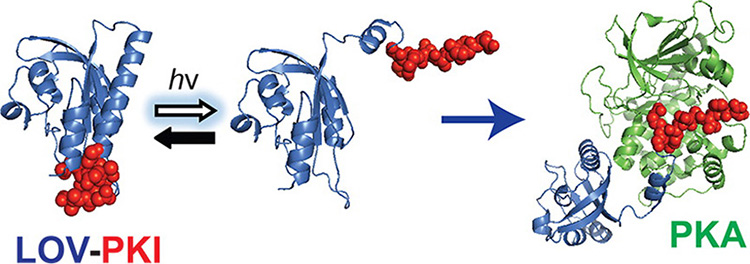
Optogenetic control of endogenous signaling can be an important tool for probing cell behavior. Using the photoresponse of LOV2, we developed analogues of kinase inhibitors whose activity is light dependent. Inhibitory peptides were appended to the Jα helix, where they inhibited kinases in the light but were sterically blocked from kinase interaction in the dark. In the example shown here PKI (red) is an inhibitor of PKA (green). The LOV domain is shown in blue.
LOV is photoactivated very rapidly (< 0.5 milliseconds). The half time for return to the dark state can be adjusted using point mutations (in our hands from 1.7 to 496 seconds, Curr. Protoc. Cell Biol., 73: 21.10.1-14, 2016). Rapid return times are useful for precise kinetic control. Slower return times enable continuous activation with only a brief pulse of light every few minutes.
References
Elston, N.R., Pablo, M., Pimenta, F., Hahn, K.M., and Watanabe, T. Optogenetic inhibition and activation of Rac and Rap1 using a modified iLID system. bioRxiv, Dec. 11, 2020. online article
Yi, J.J., Wang, H., Vilela, M., Danuser, G., and Hahn, K.M. Manipulation of endogenous kinase activity in living cells using photoswitchable inhibitory peptides. ACS Synth. Biol., 3(11): 788-95, 2014. PMC4277778. Online article | Free PMC article
~ Updated 04/08/2021